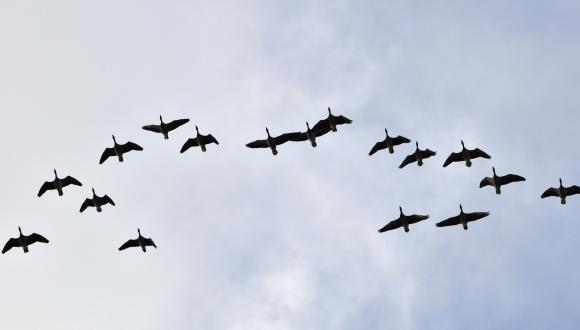Solway Barnacle Goose Management Scheme
This scheme supports sustainable populations of wintering Svalbard barnacle geese on the Solway while limiting agricultural damage and economic losses.
Scheme overview
Location: Solway estuary north shore, including land at Ruthwell, Caerlaverock and Southwick
Goose species: Barnacle goose (Svalbard population)
Population level: 41,700 from 2016-17 counts
Extent: 850 hectares approx. of agricultural land
Number of participants: 16 holdings (out of around 35 holdings known to host barnacle geese)
Duration: 4 years, from October 2017 to April 2021 (a series of one-year management agreements run from 1 October to 30 April annually)
Eligibility
To be eligible, agricultural land must:
- lie within an area of high goose use
- support an eligible crop in a suitable condition to attract geese
Eligible crop in the feeding zone is;
- grassland (permanent and rotational),
- rape,
- first- and second-year chicory/grass mix
- undersown stubble.
Eligible crop in the buffer zone is;
- grassland (permanent and rotational),
- winter cereals,
- rape,
- third-year chicory/grass
- undersown stubble.
View the map of eligible fields below.
Read the Solway Barnacle Goose Management Scheme eligibility table.
How to apply
You must identify on a map the locations of any areas to be managed under this Scheme each year, and the management option that applies to each field.
You must keep records of:
- reseed frequency for pasture on your holding
- silage cutting dates
- silage yield
- stock turnout dates
You should submit this information with your application to join the scheme.
Download the Solway Barnacle Goose Management Scheme application form
Management requirements from 1 October to 31 March (inclusive)
Provision of undisturbed feeding refuge
- Provide undisturbed ground for goose feeding.
- Apply extra fertiliser in the spring and autumn to make the sward attractive to geese.
- Apply fertiliser and use suitable seed mixes to establish productive grassland crops for the feeding zone.
- You must get permission in advance from NatureScot to plough feeding zone ground before 31 March.
Scaring
- Use only ‘non-lethal quiet’ methods to scare geese from first-year reseeds in the feeding zone (i.e. no gas guns, rope bangers or shooting).
- Non-lethal quiet scaring is also to be used in any buffer area to avoid disturbing geese from the feeding zone.
- Land managers who choose to undertake non-lethal scaring are responsible for buying and erecting any scaring equipment.
- You must get a licence to shoot barnacle geese if you wish to use lethal scaring methods.
Payment
View the Solway Goose Management Scheme Payment rates
Monitoring
Goose numbers and distribution
- Goose counts are carried out within a fortnightly cycle from November to March. A total of 14 counts are completed per season.
- Population counts (international) of the Upper Solway landward area take place weekly in October, April and May, and monthly in winter.
- Counts of the entire Solway are also carried out at times to indicate other possible resorts used by barnacle geese.
Proportion of the goose population supported by the scheme
We use recent goose counts to estimate the proportion of the goose population supported under the scheme.
Farmer perception monitoring
NatureScot will undertake a questionnaire survey of scheme participants to help provide feedback on their level of satisfaction and the levels of damage caused by geese.
Inspections
The following ensure compliance with the scheme’s eligibility criteria and management requirements.
Before land joins the scheme, NatureScot will check its goose count data for the last 10 years and the current year’s Integrated Administration and Control System (IACS) data. The land may be visited to ensure it meets the eligibility criteria.
Field size and boundary data will be checked against current IACS data before payments are made. Field size is checked, and payments are made, against the net field area stated on the current season’s Single Application Form.
While the scheme is operating, only quiet scaring methods may be used on first-year reseeds within feeding zone and in buffer areas. Inspectors will note where and when scaring devices are in use.
If you carry out lethal scaring of barnacle geese, we will check that you hold a licence to do so on your land.
Goose Group meetings
The local Goose Group usually meets twice per year, with meetings in February (to review progress during the winter and discuss any issues being experienced) and July (to consider zonation for the following winter season). Minutes can be found via the link below.




